ConceptnoteIoCJan2017 (PDF)
File information
This PDF 1.5 document has been generated by / Skia/PDF m57, and has been sent on pdf-archive.com on 18/01/2017 at 16:52, from IP address 65.96.x.x.
The current document download page has been viewed 447 times.
File size: 862.79 KB (36 pages).
Privacy: public file
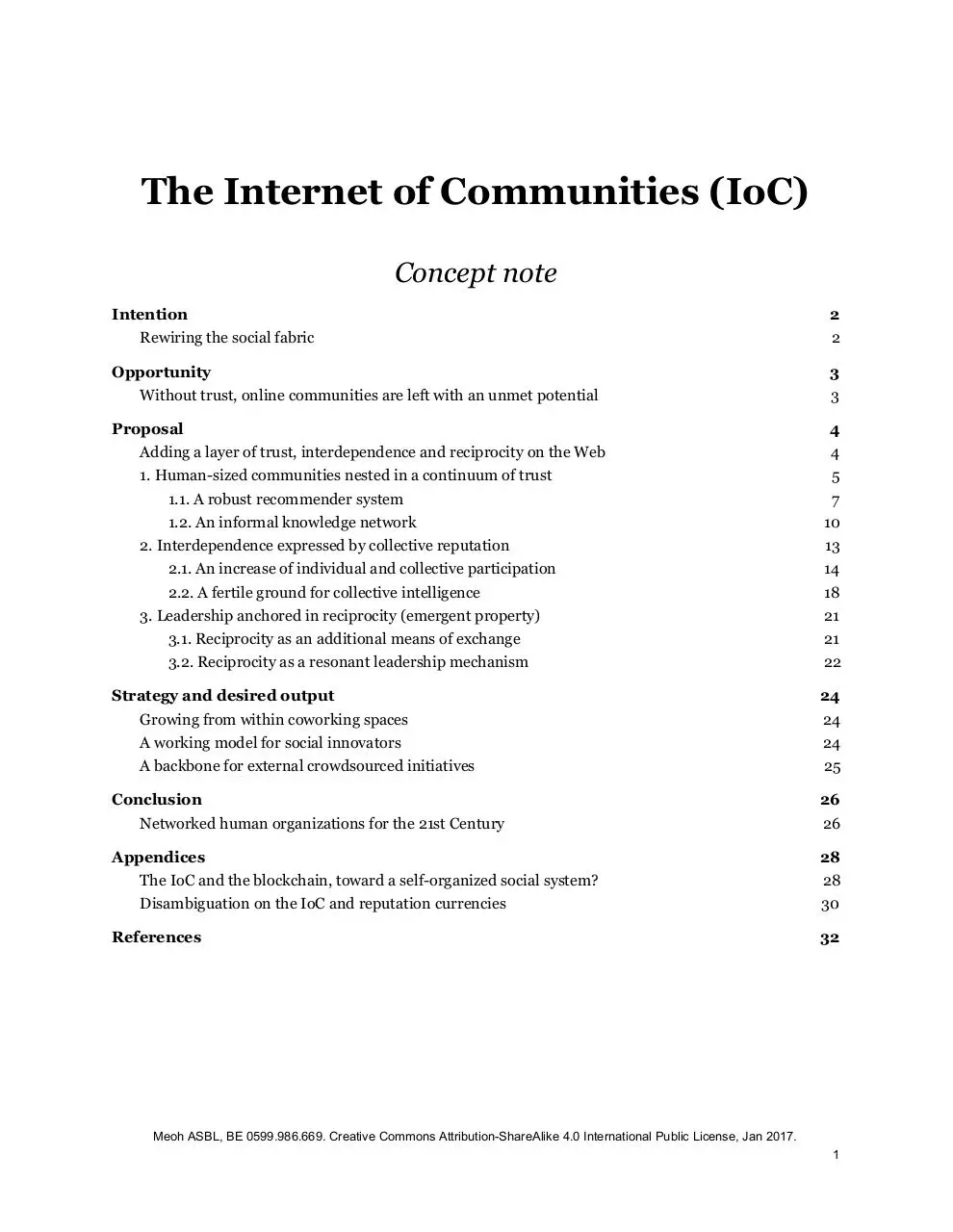
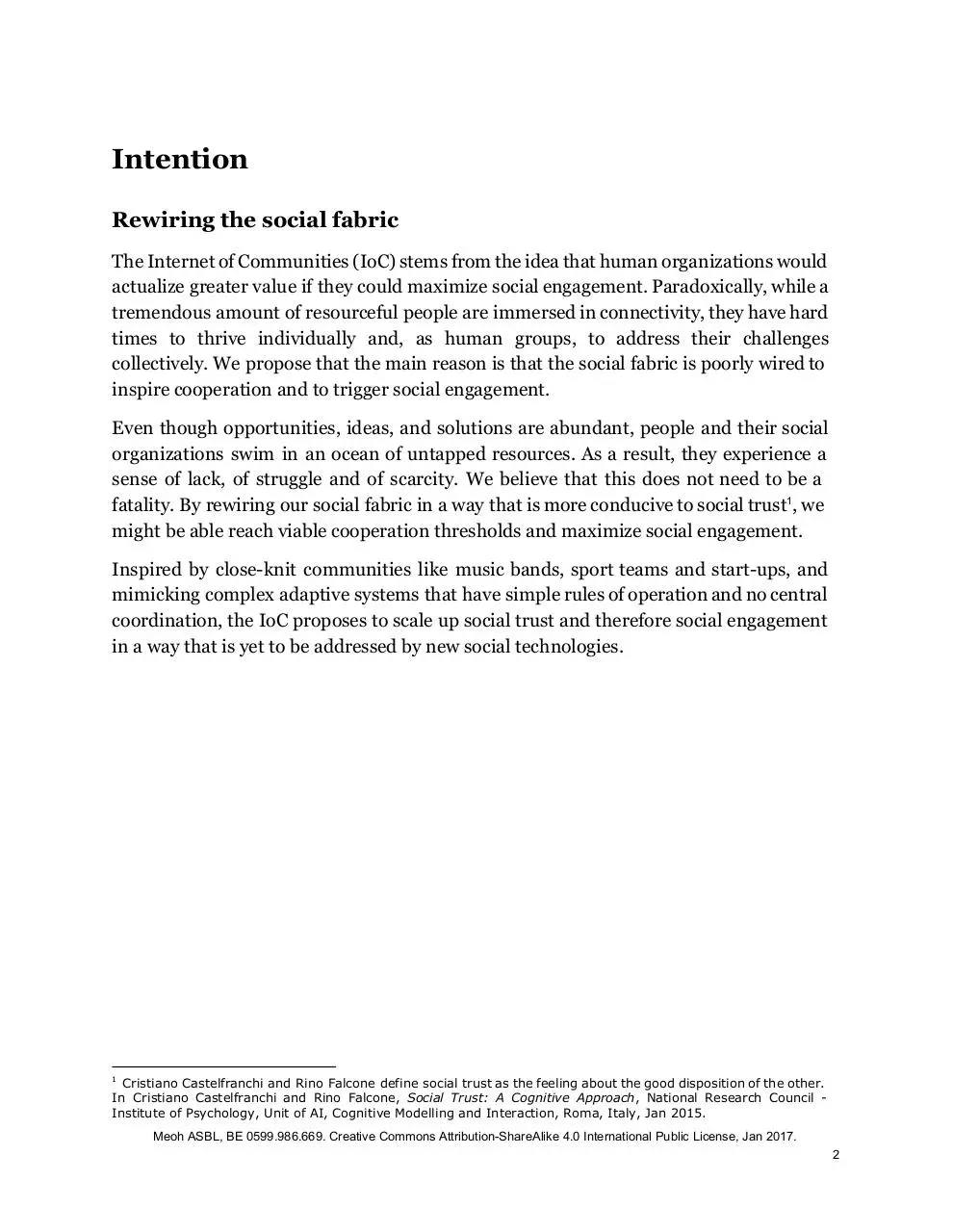
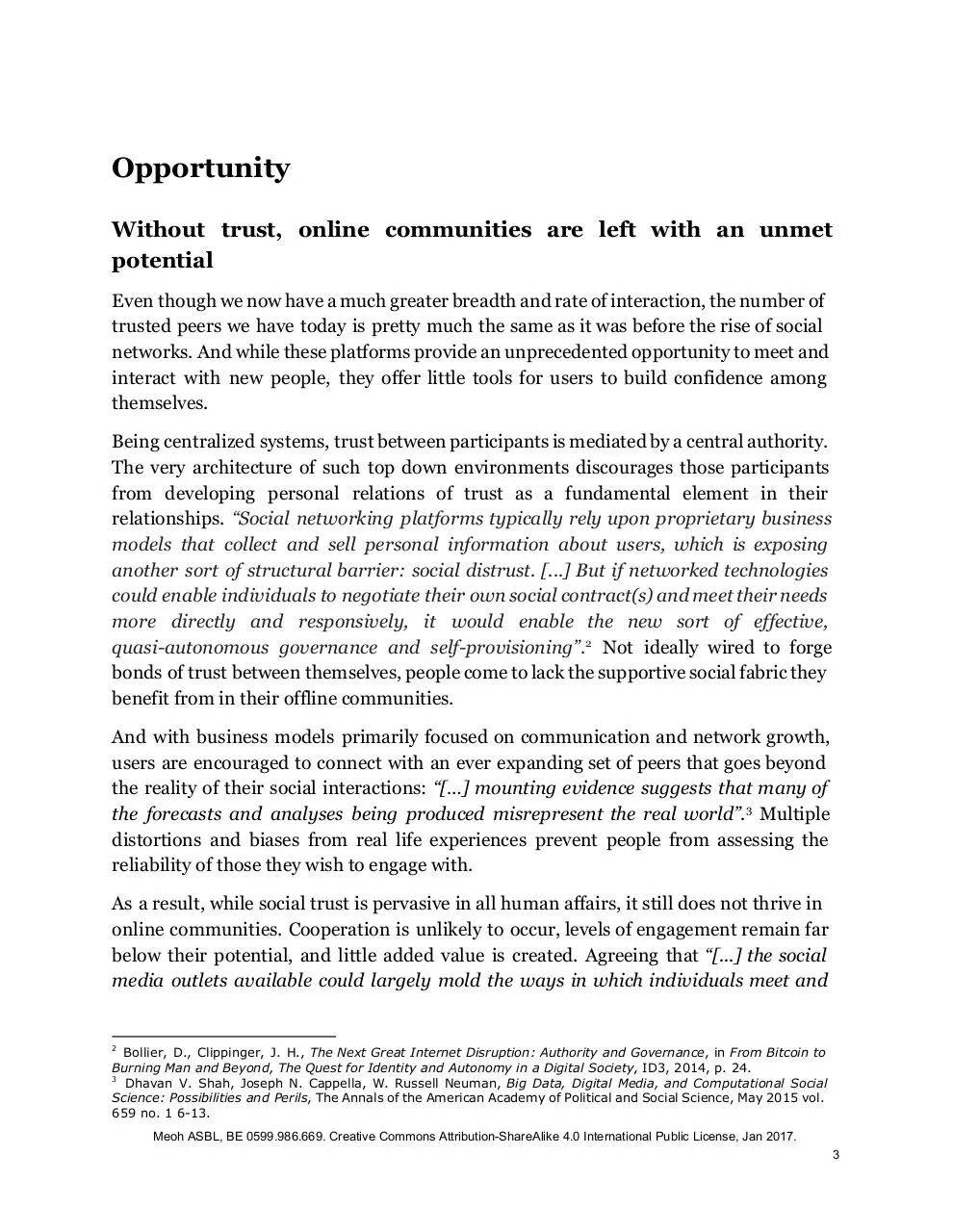
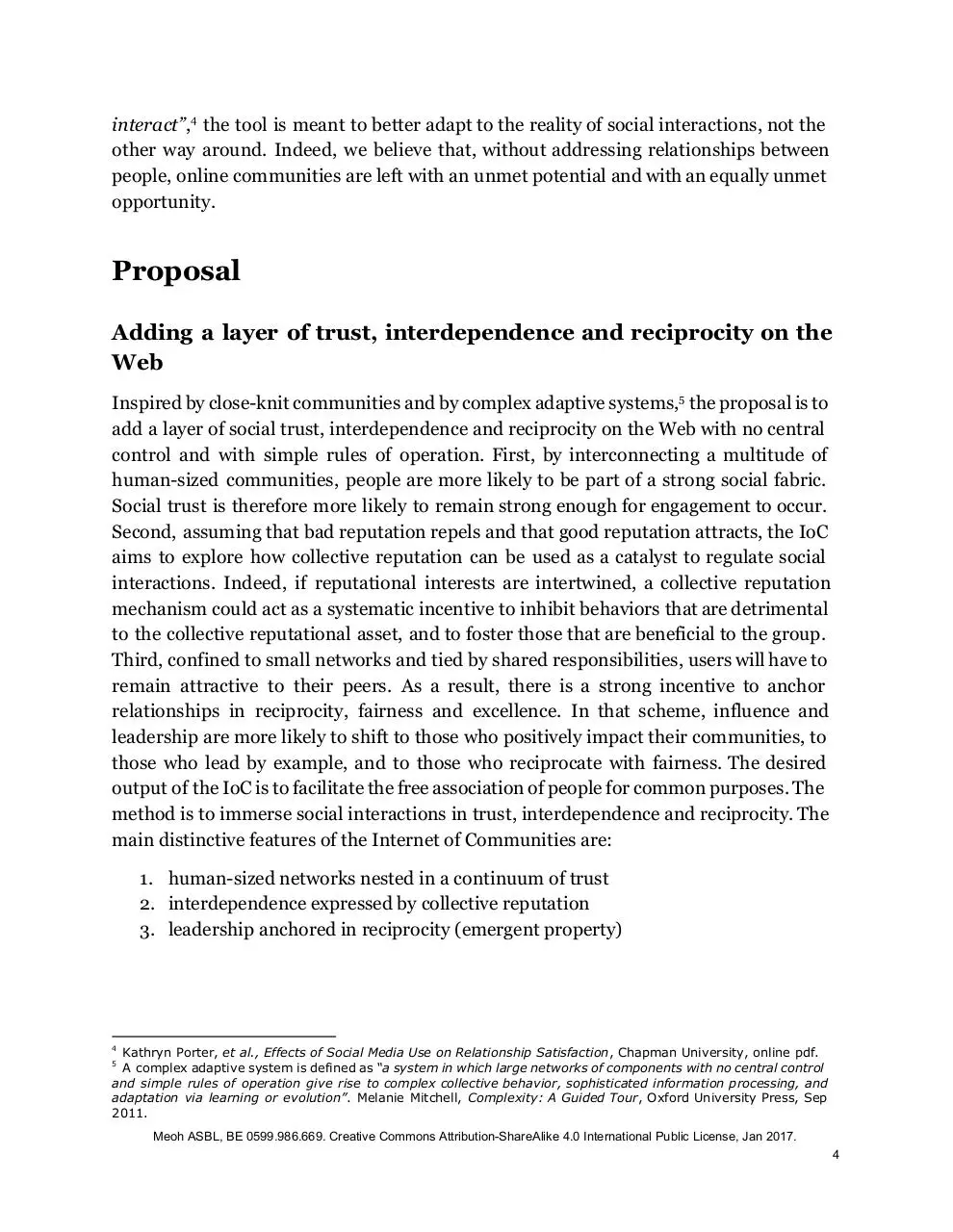
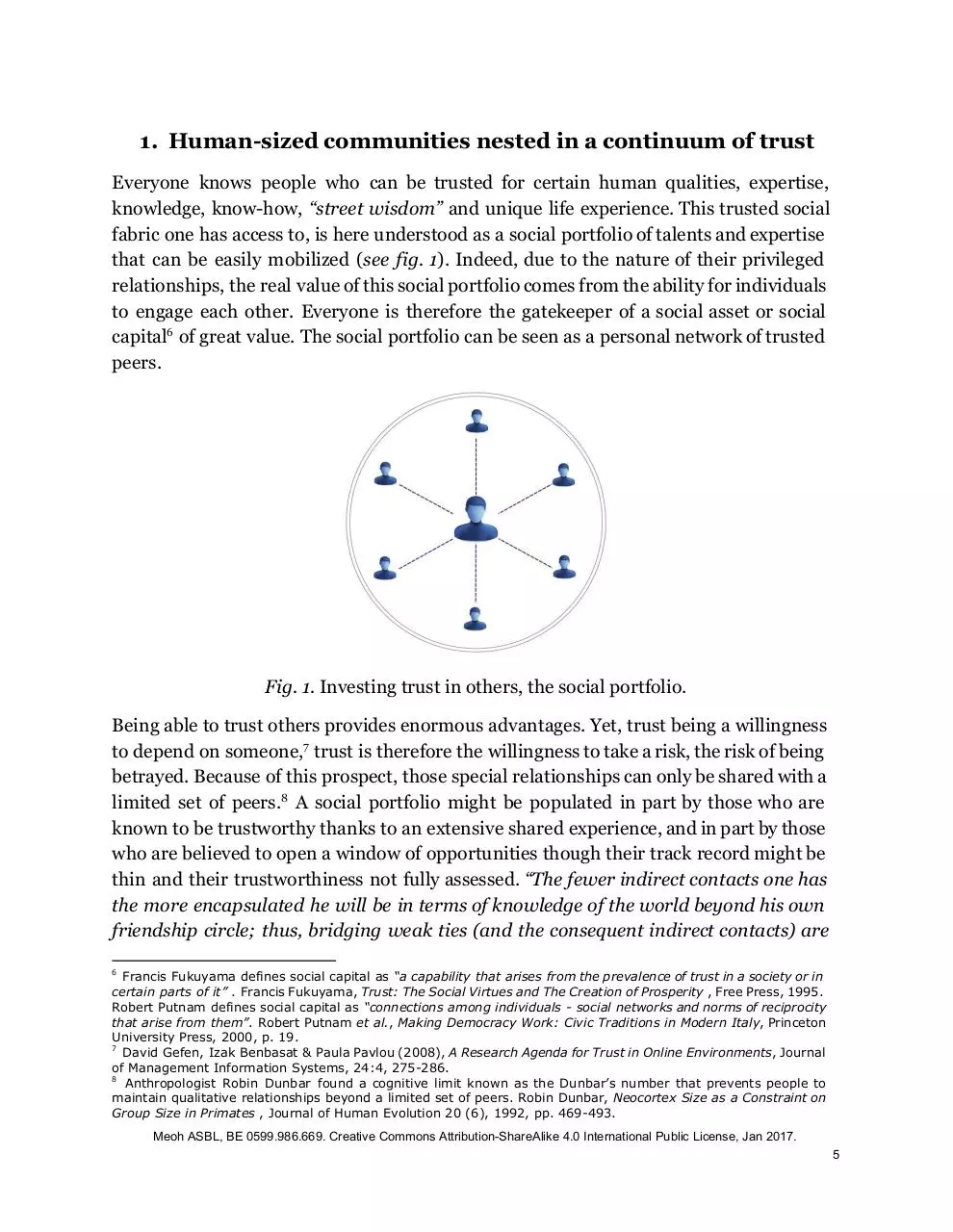
File preview
The Internet of Communities (IoC)
Concept note
Intention
Rewiring the social fabric
Opportunity
Without trust, online communities are left with an unmet potential
Proposal
Adding a layer of trust, interdependence and reciprocity on the Web
1. Human-sized communities nested in a continuum of trust
1.1. A robust recommender system
1.2. An informal knowledge network
2. Interdependence expressed by collective reputation
2.1. An increase of individual and collective participation
2.2. A fertile ground for collective intelligence
3. Leadership anchored in reciprocity (emergent property)
3.1. Reciprocity as an additional means of exchange
3.2. Reciprocity as a resonant leadership mechanism
Strategy and desired output
Growing from within coworking spaces
A working model for social innovators
A backbone for external crowdsourced initiatives
Conclusion
Networked human organizations for the 21st Century
Appendices
The IoC and the blockchain, toward a self-organized social system?
Disambiguation on the IoC and reputation currencies
References
2
2
3
3
4
4
5
7
10
13
14
18
21
21
22
24
24
24
25
26
26
28
28
30
32
Meoh ASBL, BE 0599.986.669. Creative Commons Attribution-ShareAlike 4.0 International Public License, Jan 2017.
1
Intention
Rewiring the social fabric
The Internet of Communities (IoC) stems from the idea that human organizations would
actualize greater value if they could maximize social engagement. Paradoxically, while a
tremendous amount of resourceful people are immersed in connectivity, they have hard
times to thrive individually and, as human groups, to address their challenges
collectively. We propose that the main reason is that the social fabric is poorly wired to
inspire cooperation and to trigger social engagement.
Even though opportunities, ideas, and solutions are abundant, people and their social
organizations swim in an ocean of untapped resources. As a result, they experience a
sense of lack, of struggle and of scarcity. We believe that this does not need to be a
fatality. By rewiring our social fabric in a way that is more conducive to social trust1, we
might be able reach viable cooperation thresholds and maximize social engagement.
Inspired by close-knit communities like music bands, sport teams and start-ups, and
mimicking complex adaptive systems that have simple rules of operation and no central
coordination, the IoC proposes to scale up social trust and therefore social engagement
in a way that is yet to be addressed by new social technologies.
1
Cristiano Castelfranchi and Rino Falcone define social trust as the feeling about the good disposition of the other.
In Cristiano Castelfranchi and Rino Falcone, Social Trust: A Cognitive Approach, National Research Council Institute of Psychology, Unit of AI, Cognitive Modelling and Interaction, Roma, Italy, Jan 2015.
Meoh ASBL, BE 0599.986.669. Creative Commons Attribution-ShareAlike 4.0 International Public License, Jan 2017.
2
Opportunity
Without trust, online communities are left with an unmet
potential
Even though we now have a much greater breadth and rate of interaction, the number of
trusted peers we have today is pretty much the same as it was before the rise of social
networks. And while these platforms provide an unprecedented opportunity to meet and
interact with new people, they offer little tools for users to build confidence among
themselves.
Being centralized systems, trust between participants is mediated by a central authority.
The very architecture of such top down environments discourages those participants
from developing personal relations of trust as a fundamental element in their
relationships. “Social networking platforms typically rely upon proprietary business
models that collect and sell personal information about users, which is exposing
another sort of structural barrier: social distrust. [...] But if networked technologies
could enable individuals to negotiate their own social contract(s) and meet their needs
more directly and responsively, it would enable the new sort of effective,
quasi-autonomous governance and self-provisioning”.2 Not ideally wired to forge
bonds of trust between themselves, people come to lack the supportive social fabric they
benefit from in their offline communities.
And with business models primarily focused on communication and network growth,
users are encouraged to connect with an ever expanding set of peers that goes beyond
the reality of their social interactions: “[…] mounting evidence suggests that many of
the forecasts and analyses being produced misrepresent the real world”.3 Multiple
distortions and biases from real life experiences prevent people from assessing the
reliability of those they wish to engage with.
As a result, while social trust is pervasive in all human affairs, it still does not thrive in
online communities. Cooperation is unlikely to occur, levels of engagement remain far
below their potential, and little added value is created. Agreeing that “[...] the social
media outlets available could largely mold the ways in which individuals meet and
2
Bollier, D., Clippinger, J. H., The Next Great Internet Disruption: Authority and Governance, in From Bitcoin to
Burning Man and Beyond, The Quest for Identity and Autonomy in a Digital Society, ID3, 2014, p. 24.
3
Dhavan V. Shah, Joseph N. Cappella, W. Russell Neuman, Big Data, Digital Media, and Computational Social
Science: Possibilities and Perils, The Annals of the American Academy of Political and Social Science, May 2015 vol.
659 no. 1 6-13.
Meoh ASBL, BE 0599.986.669. Creative Commons Attribution-ShareAlike 4.0 International Public License, Jan 2017.
3
interact”,4 the tool is meant to better adapt to the reality of social interactions, not the
other way around. Indeed, we believe that, without addressing relationships between
people, online communities are left with an unmet potential and with an equally unmet
opportunity.
Proposal
Adding a layer of trust, interdependence and reciprocity on the
Web
Inspired by close-knit communities and by complex adaptive systems,5 the proposal is to
add a layer of social trust, interdependence and reciprocity on the Web with no central
control and with simple rules of operation. First, by interconnecting a multitude of
human-sized communities, people are more likely to be part of a strong social fabric.
Social trust is therefore more likely to remain strong enough for engagement to occur.
Second, assuming that bad reputation repels and that good reputation attracts, the IoC
aims to explore how collective reputation can be used as a catalyst to regulate social
interactions. Indeed, if reputational interests are intertwined, a collective reputation
mechanism could act as a systematic incentive to inhibit behaviors that are detrimental
to the collective reputational asset, and to foster those that are beneficial to the group.
Third, confined to small networks and tied by shared responsibilities, users will have to
remain attractive to their peers. As a result, there is a strong incentive to anchor
relationships in reciprocity, fairness and excellence. In that scheme, influence and
leadership are more likely to shift to those who positively impact their communities, to
those who lead by example, and to those who reciprocate with fairness. The desired
output of the IoC is to facilitate the free association of people for common purposes. The
method is to immerse social interactions in trust, interdependence and reciprocity. The
main distinctive features of the Internet of Communities are:
1. human-sized networks nested in a continuum of trust
2. interdependence expressed by collective reputation
3. leadership anchored in reciprocity (emergent property)
4
Kathryn Porter, et al., Effects of Social Media Use on Relationship Satisfaction, Chapman University, online pdf.
A complex adaptive system is defined as “a system in which large networks of components with no central control
and simple rules of operation give rise to complex collective behavior, sophisticated information processing, and
adaptation via learning or evolution”. Melanie Mitchell, Complexity: A Guided Tour, Oxford University Press, Sep
2011.
5
Meoh ASBL, BE 0599.986.669. Creative Commons Attribution-ShareAlike 4.0 International Public License, Jan 2017.
4
1. Human-sized communities nested in a continuum of trust
Everyone knows people who can be trusted for certain human qualities, expertise,
knowledge, know-how, “street wisdom” and unique life experience. This trusted social
fabric one has access to, is here understood as a social portfolio of talents and expertise
that can be easily mobilized (see fig. 1). Indeed, due to the nature of their privileged
relationships, the real value of this social portfolio comes from the ability for individuals
to engage each other. Everyone is therefore the gatekeeper of a social asset or social
capital6 of great value. The social portfolio can be seen as a personal network of trusted
peers.
Fig. 1. Investing trust in others, the social portfolio.
Being able to trust others provides enormous advantages. Yet, trust being a willingness
to depend on someone,7 trust is therefore the willingness to take a risk, the risk of being
betrayed. Because of this prospect, those special relationships can only be shared with a
limited set of peers.8 A social portfolio might be populated in part by those who are
known to be trustworthy thanks to an extensive shared experience, and in part by those
who are believed to open a window of opportunities though their track record might be
thin and their trustworthiness not fully assessed. “The fewer indirect contacts one has
the more encapsulated he will be in terms of knowledge of the world beyond his own
friendship circle; thus, bridging weak ties (and the consequent indirect contacts) are
6
Francis Fukuyama defines social capital as “a capability that arises from the prevalence of trust in a society or in
certain parts of it” . Francis Fukuyama, Trust: The Social Virtues and The Creation of Prosperity , Free Press, 1995.
Robert Putnam defines social capital as “connections among individuals - social networks and norms of reciprocity
that arise from them”. Robert Putnam et al., Making Democracy Work: Civic Traditions in Modern Italy, Princeton
University Press, 2000, p. 19.
7
David Gefen, Izak Benbasat & Paula Pavlou (2008), A Research Agenda for Trust in Online Environments, Journal
of Management Information Systems, 24:4, 275-286.
8
Anthropologist Robin Dunbar found a cognitive limit known as the Dunbar’s number that prevents people to
maintain qualitative relationships beyond a limited set of peers. Robin Dunbar, Neocortex Size as a Constraint on
Group Size in Primates , Journal of Human Evolution 20 (6), 1992, pp. 469-493.
Meoh ASBL, BE 0599.986.669. Creative Commons Attribution-ShareAlike 4.0 International Public License, Jan 2017.
5
important in both ways”.9 Therefore, individuals are encouraged to balance risks and
opportunities by teaming up with those who are known to be reliable on one hand, and
on the other hand, with those who are more risky in terms of reliability but who are also
more likely to increase their chance to connect with new social landscapes and meet new
opportunities.
Fig. 2. People are both at the center of a micro social world and at the verge of many
others.
People are at the center of their micro social world and at the verge of many others,
meaning that they have a foot in various communities (see fig. 3). Everyone can
therefore match a need expressed in a community with a corresponding resource found
in another one. Like in real life, trusted peers are the doorways to a wider array of
people and resources beyond what one has usually access to. The motive for individuals
to bridge different micro social worlds could be manifold. Some may want to find
complementary talents and missing expertise for their projects, some others may want
to be the catalysts of potential success stories and enable win-win opportunities for
themselves and their peers, and some others may want to build up collective capacity to
access greater resources than possible individually.
9
Mark S. Granovetter, The Strength of Weak Ties, American Journal of Sociology, Volume 78, Issue 6 (May, 1973),
pp. 1360–1380, p. 1371.
Meoh ASBL, BE 0599.986.669. Creative Commons Attribution-ShareAlike 4.0 International Public License, Jan 2017.
6
Fig. 3. User-centric network. Everyone
being immersed in a social fabric, useful
resources might be just a few handshakes
away.
Fig. 4. A three degrees network: 1st°
trusted peers (social portfolio), 2nd° pool
of available resources within easy reach
(friends of friends), 3rd° zone of influence
(visibility).
The fact that people can easily mobilize their trusted peers and the fact that people are
in a unique position to make meaningful links between people who are unaware of each
others, highlight the first potential features of a network made of human-sized
communities nested in a continuum of trust. The first one is the build up of a robust
recommender system based on trusted first-hand information, and the second one is the
advancement of an informal knowledge network that materializes the trusted
relationships people maintain within, between, and beyond the social organizations they
belong to.
1.1. A robust recommender system
Most often, online recommender systems are based on reputation. Reputation is “an
information used to make a value judgment about an object or a person we don’t know
yet".10 Today’s online approaches include a lot of information provided by a lot of mostly
unknown people. “[...] users increasingly have to interact with unknown people. When
choosing their interaction partners, they often lack direct experience and are forced to
rely on ratings provided by others who are often unknown themselves”.11 Thus the
10
Randy Farmer, Bryce Glass, Building Web Reputation Systems, Yahoo! Press, 2010, p. 8.
Stephan Hammer, Rolf Kiefhaber, Matthias Redlin, Elisabeth Andre, and Theo Ungerer, A User-Centric Study Of
Reputation Metrics in Online Communities, Department of Computer Science, Augsburg University, Jan 2013, p. 1.
11
Meoh ASBL, BE 0599.986.669. Creative Commons Attribution-ShareAlike 4.0 International Public License, Jan 2017.
7
users are faced with uncertainty as to whether this information is reliable.12 While such
reputational statements have virtues, the IoC proposes to offer stronger reputational
claims that come from trusted sources, that can handle multiple dimensions of
complexity and that are more honest and authentic. For that purpose, the IoC is
designed (1) to deal with first-hand information only, and (2) to engage the reputation of
those who provide recommendations.
First, people only resort to reputation when they do not have first-hand information. In
other words, they rely on a social evaluation that strangers generate for other strangers
with the belief that collective opinion is better than ignorance. By being remote to its
source, reputation is by definition subject to distortion.13 Indeed, reputation expresses a
perception that may not reflect the inherent qualities of people: “[…] When we refer to a
person's reputation, we recognize that reputation is our perception of the person, that
it is externally derived and not necessarily intrinsic to that individual. In other words,
we understand that a person may not have complete control over the perception that
has been created”.14
Second, it becomes increasingly challenging to verify the sources that provide such
reputational information: "Distinguishing between bots and real users is a persistent
problem for social networks. Fake users are often created to help users look more
popular or to promote a product".15 And, with an increase in online social interactions,
"[...] so does the threat of agents seeking to weaken the network by propagating bad
information and services. [...] Because of this danger, users must be wary of the
quality or validity of the resources they access".16 Research has pointed out that people
tend to rely more on recommendations from people they trust (friends) than on online
recommender systems which generate recommendations based on anonymous people
similar to them.17 It is reasonable to assume that with online reputation, no information
out there is trustworthy, only the one emanating from a trusted source may. “Belief
should only be accorded to statements from people we deem trustworthy”.18 And "It
has been suggested that the future development of P2P systems will depend largely on
12
Stephan Hammer, Rolf Kiefhaber, Matthias Redlin, Elisabeth Andre, and Theo Ungerer, A User-Centric Study Of
Reputation Metrics in Online Communities, Department of Computer Science, Augsburg University, , p.2.
13
Cheryl Conner, Amazon Sues 1,114 Fake Reviewers On Fiverr, Forbes, October 18 2015.
14
Governor Sarah Bloom Raskin, Reflections on Reputation and its Consequences, at the 2013 Banking Outlook
Conference at the Federal Reserve Bank of Atlanta, Atlanta, Georgia, February 28, 2013.
15
Deepa Seetharaman, Fake Accounts Still Plague Instagram Despite Purge, Study Finds, The Wall Street Journal,
US Edition, June 30, 2015.
16
Sergio Marti and Hector Garcia-Molina, Examining Metrics for Peer-to-Peer Reputation Systems, Technical report,
Stanford University, 2008.
17
Patricia Victor, Chris Cornelis, Martine De Cock, Trust and Recommendations, Dept.of Applied Mathematics and
Computer Science, Ghent University, and Institute of Technology, University of Washington Tacoma. Also “Nielsen:
Global Consumers’ Trust in ‘Earned’ Advertising Grows in Importance”, April 10, 2012.
18
Cai-Nicolas Ziegler, On Propagating Interpersonal Trust in Social Networks, in Computing with Social Trust, Human-Computer
Interaction Series, Springer, 2009, p. 133.
Meoh ASBL, BE 0599.986.669. Creative Commons Attribution-ShareAlike 4.0 International Public License, Jan 2017.
8
the availability of novel methods for ensuring that peers obtain reliable information on
the quality of resources they are receiving”.19
Moreover, reputation evolves over time, depends on context, and is subject to personal
interpretations. Therefore, while global ratings and trust scores have value when no
better information is at disposal, they imply a necessary trade off in terms of accuracy
and relevancy. On the contrary, "Local Trust Metrics"20 , or techniques able to predict
the trustworthiness of a user in a personalized way, depend on the very personal view of
individuals. Local Trust Metrics, in this sense, better correspond to the traditional
approach of gathering information about someone’s reputation which entails asking
only a small number of trusted people. This results in a smaller amount of information,
but also in mostly credible information. In the IoC, individuals do not need to rely on
reputation because every new interaction is initiated and introduced by a trusted peer.
Individuals can take advantage of the degree to which everyone knows everyone else to
deliver first-hand and tailored information across their networks. The IoC is not about
relying on the objectivity of reputational statements that can never be determined,
instead it is about relying on the subjective opinion of the peers people trust.
Following that individuals provide first-hand, personalized and contextualized
information, they engage their integrity toward their peers who will eventually respond
in direct proportion. The main difference with traditional reputation systems resides in
the fact that, while it does not cost much to individuals to express biased reputational
claims for strangers, a breach in confidence with trusted peers might have devastating
effects on their relationships, and in turn on their social asset, their social portfolio. It is
probable that those concerned will not lose time in arguing endlessly. Instead, they are
more likely to translate their statements in actions as those speak louder than words. In
economics, this is coined as “revealed preference”.21 Those who generate problematic
relationships might lose access to their peers and to the groups of people behind them.
The incentive to provide fair, accurate and relevant information is therefore much
stronger if trusted relationships are at stake. Trustworthiness, or the belief in
benevolence, ability and integrity of peers, is thus framed by intertwined reputational
interests.
19
Rod Collins, Is Hierarchy Really Necessary?, The Huffington Post, US Edition, 05/05/2016.
http://wiki.p2pfoundation.net/Trust_Metrics
21
Paul Samuelson, A Note on the Pure Theory of Consumers' Behaviour, Economaica 5 (17): 61–71. JSTOR
2548836.
20
Meoh ASBL, BE 0599.986.669. Creative Commons Attribution-ShareAlike 4.0 International Public License, Jan 2017.
9
Download ConceptnoteIoCJan2017
ConceptnoteIoCJan2017.pdf (PDF, 862.79 KB)
Download PDF
Share this file on social networks
Link to this page
Permanent link
Use the permanent link to the download page to share your document on Facebook, Twitter, LinkedIn, or directly with a contact by e-Mail, Messenger, Whatsapp, Line..
Short link
Use the short link to share your document on Twitter or by text message (SMS)
HTML Code
Copy the following HTML code to share your document on a Website or Blog
QR Code to this page
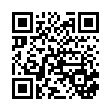
This file has been shared publicly by a user of PDF Archive.
Document ID: 0000538568.